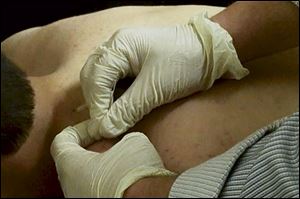
Turf war created over dry needling
Physical therapists enter unwanted competition with acupuncturists
2/10/2014
A patient receives a dry needling treatment.
PHOENIX — Golf instructor Chuck McDevitt had tried everything — physical therapy, exercise, acupuncture — to alleviate pain in his knees and back.
At the suggestion of his physical therapist, Sean Flannagan, he decided to try dry needling, a pain-relief technique that uses ultra-thin needles to poke into and stimulate muscle tissue.
“I had acupuncture before that was supposed to heal something in my back,” McDevitt said. “But I needed spinal manipulation, and I needed some dry needling that actually addressed some of the muscle restrictions that I had — not a lack of energy flow.”
While the technique has been approved by the state board that oversees physical therapists, it has ignited a turf war with acupuncturists who say physical therapists don’t have enough training to use needles.
“This culture of casualness around acupuncture is hurting people,” said Lloyd Wright, an acupuncturist and traditional Chinese medicine practitioner with Stellar Physical Medicine in Scottsdale, Ariz.
But Flannagan, who has been using dry needling to treat pain for five years, said safety concerns are just a way for acupuncturists to attempt to shut out physical therapists from using needles.
“They want the public to believe they’re the experts on needling,” he said. “No one profession owns any modality. They share.”
The Arizona Physical Therapy Board started investigating the practice of dry needling in 2012 and determined late last year that it falls within the scope of practice for physical therapists. But the board decided that it didn’t have the authority under state law to set any training standards.
"It's going to be up to the Legislature to determine if they want to alter the laws to see if they want to add that authority," said Charles Brown, executive director for the board. "If they want this technique to be singled out for initial competency requirement, they can give that to the board. Or they can leave the laws alone, and it would be the status quo that it's a technique within the scope of practice."
Rep. Paul Boyer (R., Phoenix), vice chairman of the House Health Committee, said board members worked with legal advisers to determine if they could set these standards.
"All the board can do is follow the language as it's written," Boyer said. "The board believes they're within their duties by adhering to the rule of law."
The House Health Committee will be having meetings for various stakeholders on the dry needling issue in coming weeks and determine a course of action, he said.
While Wright said he would like to see some standards set for dry needling, Flannagan said his training already sets standards, including the type of sanitary practices dry needling requires. Flannagan took additional training courses on dry needling after finishing his Doctor of Physical Therapy degree.
"For me to even sit in these courses, I had to have bachelor's and doctorate degrees," Flannagan said.
He said acupuncturists and physical therapists look at the body in different ways and that patients will choose which route is best for them.
"It's kind of a one-way turf battle," Flannagan said. "We don't want to restrict acupuncture at all."
Brown said the Physical Therapy Board would investigate individual claims from patients to make sure physical therapists are meeting a standard of care and would follow up with enforcement if needed. But the board hasn't received any patient complaints about dry needling, he said.
"All the complaints we've received have been from sources other than patients," he said.
Wright said his primary concern is the patient, and ensuring a safe and effective practice. He said the board should set a minimum standard of training for dry needling by involving industry experts, including acupuncturists, in the process.
Acupuncturists need at least 1,850 hours of training, including 800 hours of clinical experience, in order to practice, according to the Arizona Acupuncture Board of Examiners.
"Putting in needles is an invasive procedure," Wright said. "When you venture into piercing the skin, it's a whole other realm."